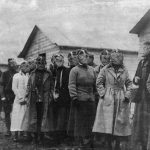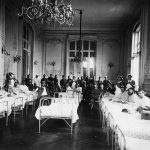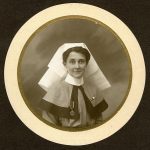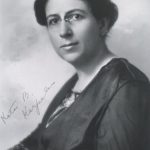The Hopkins and the Great War exhibit features the stories of several women veterans of World War I . By exploring the experiences of the female Johns Hopkins doctors and nurses, the exhibit sheds light on the opportunities women had to serve during the war and the ways in which gendered norms varied by professional training and nationality.
The network of professional nurses, organized through the American Red Cross, demonstrated the need and value of having trained nurses serve as part of medical units to care for sick and injured soldiers. Hundreds of American nurses first entered the war during the period of American neutrality as a part of the American Red Cross Mercy Ship Units that were stationed at hospitals in both Allied and Central Power nations. The exhibit tells the story of Alice Henderson and Vashti Bartlett, two of the Hopkins nurses who served with the Red Cross unit in Pau, France in 1914-1915.
In October 1915 when the American Red Cross closed the Mercy Ship Units due to lack of funding, Bartlett and her unit relocated to La Panne, Belgium, serving at a hospital on the Belgian front until recalled in May 1916. The exhibit also includes the stories of other Hopkins nurses who served with British, Canadian, French, and Serbian medical units before the United States entered the war in 1917.
Alice Fitzgerald received several medals for her work from 1916-1917 as the Edith Cavell Memorial Nurses serving with the British Expeditionary Forces. Ellen La Motte described her nursing experience with the Ambulance Americaine in her anti-war book, The Backwash of War (1916).
After the United States declared war in 1917, over 10,000 female nurses served overseas as members of the Army Nurses Corps stationed with medical units. The Johns Hopkins Base Hospital Unit 18 was the first US Army medical unit sent to France, arriving with the first division of American troops in June 1917 with 65 nurses to serve a 1000 bed hospital. The service of so many women, particularly nurses, during the war proved to be a persuasive rallying call in their successful campaign for women’s suffrage as “Justice for Women as a War Measure”.
While the Red Cross and US Army encouraged tens of thousands of American woman to serve as nurses both in the United States and overseas, very few American women physicians had the same opportunity to serve during World War I. The exhibit includes the stories of two women physicians with Hopkins affiliations, one American and one British, who did serve.
Kate Bogel Karpeles, an American 1914 graduate of the Johns Hopkins University School of Medicine, in 1918 became the first woman doctor to sign a contract with the US Army in World War I. The US Army assigned her to an army emergency dispensary in Washington, DC because women physicians were not offered the opportunity to serve overseas. She was active with the American Medical Women’s Association and made a career out of pushing for women physicians’ rights in civilian and military medicine.
Unlike the US Army, the British medical corps when faced with a shortage of male doctors accepted many women physicians into its ranks and allowed them to serve in front line military hospitals. Elizabeth Hurdon, the first woman to serve on the staff of the Johns Hopkins Hospital and the faculty of the Johns Hopkins University School of Medicine, was one of 82 British women physicians who served as part of the Women’s Medical Unit in the Malta Garrison which treated casualties from the Gallipoli campaign. While she initially faced difficulties in re-launching her medical career because male physicians returning from the war were given priority in academic and research positions, her career again flourished in the late 1920s in gynecological pathology and the use of radiation therapy for treatment of gynecological malignancies.
Please explore the online exhibit to learn more about the experiences of the women and men who served as doctors and nurses in the Great War.
~This post courtesy of Phoebe Evans Letocha, Collections Management Archivist, Alan Mason Chesney Medical Archives Johns Hopkins Medical Institutions.









